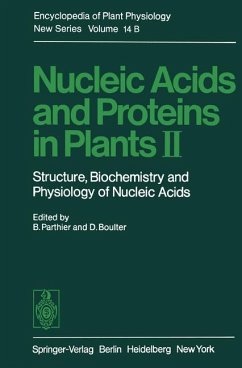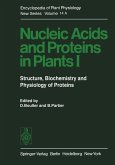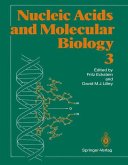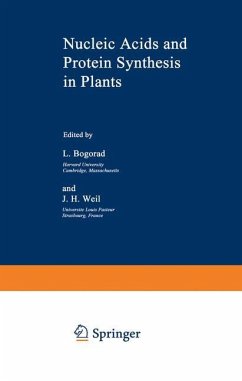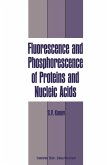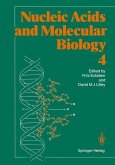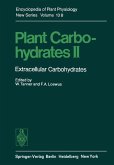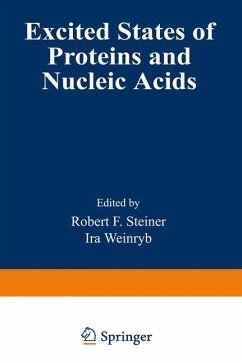Donald Boulter, Benno ParthierStructure, Biochemistry, and Physiology of Nucleic Acids
Nucleic Acids and Proteins in Plants II
Structure, Biochemistry, and Physiology of Nucleic Acids
Ed. by Benno Parthier and Donald Boulter
Donald Boulter, Benno ParthierStructure, Biochemistry, and Physiology of Nucleic Acids
Nucleic Acids and Proteins in Plants II
Structure, Biochemistry, and Physiology of Nucleic Acids
Ed. by Benno Parthier and Donald Boulter
- Broschiertes Buch
- Merkliste
- Auf die Merkliste
- Bewerten Bewerten
- Teilen
- Produkt teilen
- Produkterinnerung
- Produkterinnerung
With contributions by numerous experts
Andere Kunden interessierten sich auch für
![Nucleic Acids and Proteins in Plants I Nucleic Acids and Proteins in Plants I]() Nucleic Acids and Proteins in Plants I122,99 €
Nucleic Acids and Proteins in Plants I122,99 €![Nucleic Acids and Molecular Biology Nucleic Acids and Molecular Biology]() David M. J. LilleyNucleic Acids and Molecular Biology81,99 €
David M. J. LilleyNucleic Acids and Molecular Biology81,99 €![Nucleic Acids and Protein Synthesis in Plants Nucleic Acids and Protein Synthesis in Plants]() Nucleic Acids and Protein Synthesis in Plants41,99 €
Nucleic Acids and Protein Synthesis in Plants41,99 €![Fluorescence and Phosphorescence of Proteins and Nucleic Acids Fluorescence and Phosphorescence of Proteins and Nucleic Acids]() Sergei V. KonevFluorescence and Phosphorescence of Proteins and Nucleic Acids41,99 €
Sergei V. KonevFluorescence and Phosphorescence of Proteins and Nucleic Acids41,99 €![Nucleic Acids and Molecular Biology 4 Nucleic Acids and Molecular Biology 4]() David M. J. LilleyNucleic Acids and Molecular Biology 481,99 €
David M. J. LilleyNucleic Acids and Molecular Biology 481,99 €![Plant Carbohydrates II Plant Carbohydrates II]() Plant Carbohydrates II81,99 €
Plant Carbohydrates II81,99 €![Excited States of Proteins and Nucleic Acids Excited States of Proteins and Nucleic Acids]() Excited States of Proteins and Nucleic Acids41,99 €
Excited States of Proteins and Nucleic Acids41,99 €-
-
-
With contributions by numerous experts
Hinweis: Dieser Artikel kann nur an eine deutsche Lieferadresse ausgeliefert werden.
Hinweis: Dieser Artikel kann nur an eine deutsche Lieferadresse ausgeliefert werden.
Produktdetails
- Produktdetails
- Encyclopedia of Plant Physiology 14 / B
- Verlag: Springer / Springer Berlin Heidelberg / Springer, Berlin
- Artikelnr. des Verlages: 978-3-642-68349-7
- Softcover reprint of the original 1st ed. 1982
- Seitenzahl: 800
- Erscheinungstermin: 25. Januar 2012
- Englisch
- Abmessung: 244mm x 170mm x 43mm
- Gewicht: 1352g
- ISBN-13: 9783642683497
- ISBN-10: 3642683495
- Artikelnr.: 36115942
- Herstellerkennzeichnung Die Herstellerinformationen sind derzeit nicht verfügbar.
- Encyclopedia of Plant Physiology 14 / B
- Verlag: Springer / Springer Berlin Heidelberg / Springer, Berlin
- Artikelnr. des Verlages: 978-3-642-68349-7
- Softcover reprint of the original 1st ed. 1982
- Seitenzahl: 800
- Erscheinungstermin: 25. Januar 2012
- Englisch
- Abmessung: 244mm x 170mm x 43mm
- Gewicht: 1352g
- ISBN-13: 9783642683497
- ISBN-10: 3642683495
- Artikelnr.: 36115942
- Herstellerkennzeichnung Die Herstellerinformationen sind derzeit nicht verfügbar.
1 Nuclear Chromatin (With 16 Figures).- 1 Introduction.- 2 Chemistry of Chromatin.- 3 The Nucleosome.- 3.1 The Nucleosome Core Particle.- 3.2 The Nucleosomal DNA.- 3.3 Transcription, Replication, and Nucleosomes.- 4 Higher-Order Coiling: Chromatin Fibers.- 5 Domains and Mitotic Chromosomes.- 6 Interphase Chromatin: Heterochromatin.- 7 Interphase Chromatin: Euchromatin.- 8 Chromatin Organization and Genome Organization.- 9 Conclusions.- References.- 2 Chromosomal DNA Sequences and Their Organization (With 11 Figures).- 1 Introduction.- 2 Genome Analysis by Renaturation Kinetics.- 3 Proportions of Repeated and Non-Repeated DNA.- 4 Single-Copy and Repeated DNA Interspersion Patterns.- 5 Reverse Repeats.- 6 Genome Analysis by Equilibrium Centrifugation in Heavy Salt Gradients.- 7 Genome Analysis Using Restriction Endonucleases.- 7.1 Analysis of Whole Genome Digests After Electrophoresis and Ethidium Bromide Staining.- 7.2 Interspecies Comparisons of Major Families of Repeated Sequences.- 7.3 Sequence Analysis After Transfer to Nitrocellulose, Using Radioactive Probes.- 7.4 Analysis of Repeated DNA Families Using Restriction Endonucleases.- 7.5 Derivation of a Physical Map of the rDNA Repeat Unit in Soybean.- 8 The Properties and Arrangements of Repeated Sequences.- 9 The Structure of Nuclear Genes.- References.- 3 DNA Replication and the Cell Cycle (With 4 Figures).- 1 Introduction.- 2 Phases of the Cell Cycle.- 3 Methodology.- 3.1 Experimental Systems.- 3.1.1 Synchronous Populations of Cells.- 3.1.2 Non-Synchronous Populations of Cells.- 3.2 Techniques.- 3.2.1 Cytological Techniques.- 3.2.2 Genetic Techniques.- 3.2.3 Biochemical Techniques.- 4 Biochemistry of DNA Replication.- 4.1 General Features.- 4.2 Enzymology of DNA Replication.- 4.2.1 Endodeoxyribonuclease.- 4.2.2 DNA-Unwinding Enzyme.- 4.2.3 DNA-Binding Proteins.- 4.2.4 RNA Polymerase.- 4.2.5 DNA Polymerase.- 4.2.6 Ribonuclease H.- 4.2.7 DNA Ligase.- 4.2.8 DNA Methylase.- 5 DNA Replication and Chromatin Structure.- 5.1 General Features.- 5.2 Chromatin Organization at the Replication Origins.- 5.3 Movement of the Replication Fork.- 5.4 Re-Assembly of Chromatin.- 6 Relationship Between DNA Replication and Cell Division.- 7 Regulation of the Cell Cycle.- 7.1 Biochemical Aspects of Regulation.- 7.1.1 Ribonucleotide Reductase.- 7.1.2 Endodeoxyribonuclease.- 7.1.3 DNA Polymerase.- 7.1.4 Histone Hl Phosphokinase.- 7.1.5 General Aspects of Biochemical Regulation.- 7.2 Physiological Aspects of Regulation.- 8 Concluding Remarks.- References.- 4 DNA Endoreduplication and Differential Replication (With 8 Figures).- 1 Introduction.- 2 Somatic Polyploidization Cycles.- 2.1 Polyenergid Cells.- 2.2 Nuclear Restitution Cycles.- 2.3 Endo-Cycles.- 3 Differential DNA Replication.- 4 Physiological Significance of Somatic DNA Increase.- 5 An Evolutionary Perspective.- 6 Conclusions.- References.- 5 RNA Polymerase and Regulation of Transcription (With 8 Figures).- 1 Introduction.- 2 RNA Polymerases from Prokaryotes and Eukaryotes.- 2.1 Structure and Function.- 2.2 Regulation.- 3 Plant RNA Polymerases.- 3.1 Nuclear RNA Polymerases.- 3.1.1 Isolation and Separation.- 3.1.2 Subunit Structure.- 3.1.3 General Properties.- 3.1.4 Localization and Function.- 3.2 Chloroplast RNA Polymerase.- 3.2.1 Isolation.- 3.2.2 Properties of the Enzyme.- 3.2.3 Subunit Composition.- 3.2.4 In Vitro Products.- 4 Regulation of Transcription.- 4.1 RNA Synthesis Düring Development.- 4.1.1 Seed Germination.- 4.1.2 Hormonal Response.- 4.1.3 Photomorphogenesis.- 4.2 Mechanisms of Control of Transcription.- 4.2.1 Selective GeneRecognition.- 4.2.2 Alterations in the Level of RNA Polymerases and Modulation of Polymerase Activity.- 4.2.3 Template Availability.- 4.2.4 Factors Influencing Polymerase Activity and Specificity.- 4.2.5 Chloroplast RNA Polymerase.- 5 Conclusions.- References.- 6 RNA Sequences (With 4 Figures).- 1 Introduction.- 2 Conventions for the Graphical Representation of RNA Sequences.- 3 Structure of tRNA.- 3.1 Specific Plant tRNA Sequences.- 3.1.1 Sequences of Cytosolic tRNA's.- 3.1.2 Sequences of Organelle tRNA's.- 4 mRNA Structure.- 4.1 Cytosolic mRNA.- 4.2 Specific Cytosolic mRNA Sequences.- 4.3 Organelle mRNA's.- 5 Types of Ribosomal RNA.- 5.1 High Molecular Weight Ribosomal RNA Sequences.- 5.2 Low Molecular Weight Ribosomal RNA Sequences.- 6 Prospects.- References.- 7 RNA Processing and Other Post-Transcriptional Modifications (With 14 Figures).- 1 Introduction.- 2 Methods of Studying RNA Processing.- 3 Synthesis and Processing of rRNA.- 3.1 Processing of rRNA Transcripts in Bacteria.- 3.2 Blue-Green Algae.- 3.3 Chloroplasts and Mitochondria.- 3.4 Processing of Cytoplasmic rRNA in Nucleoli of Eukaryotes.- 4 Processing of tRNA.- 4.1 Bacteria.- 4.2 Eukaryotes.- 5 Processing of mRNA.- 5.1 General Features.- 5.2 Capping.- 5.3 Polyadenylation.- 5.4 Splicing.- References.- 8 Ribonucleases and Ribonucleic Acid Breakdown.- 1 RNA-Splitting Enzymes.- 1.1 Definitions, Terminology, and Classification.- 1.2 Problems of Purification and Identification.- 1.2.1 Formation of Artifacts by Oxido-Reductive Processes.- 1.2.2 Formation of Artifacts Due to Proteolytic Effects.- 1.2.3 Dependence of the pH Optima on a Variety of Factors.- 1.2.4 The Use of Homopolymers for the Assay of Base Specificity.- 1.2.5 Electrophoretic Variants.- 1.3 Types of RNA-Splitting Enzymes in Plants.- 1.4Subcellular Localization.- 1.4.1 Soluble Enzymes.- 1.4.2 Particle-Bound Enzymes.- 1.4.3 Lysosomal Localization.- 1.5 RNA-Splitting Enzymes in Relation to Development.- 1.5.1 Seed Germination.- 1.5.2 Seed Maturation.- 1.5.3 Root Growth and Differentiation.- 1.5.4 Senescence.- 1.6 RNA-Splitting Enzymes and the Environment.- 1.6.1 Effect of Cellular Injury.- 1.6.2 Nucleolytic Enzymes in the Diseased Plant.- 1.6.3 Light Effects.- 1.6.4 Water Stress.- 1.7 Control ofRNase Activity.- 1.7.1 Genetic Control.- 1.7.2 Hormonal Control.- 2 Ribonucleic Acid Degradation.- 2.1 RNA "Level", "Breakdown", and "Turnover", Use and Mis-Use of the Terms and Methods.- 2.2 RNA Breakdown During Specific Physiological Processes.- 2.2.1 Seed Germination.- 2.2.2 Senescence.- 2.2.3 Pathological Processes.- 2.3 Regulation of RNA Breakdown.- 2.3.1 Hormonal Regulation.- 2.3.2 Light Effects.- References.- 9 Metabolism of Pyrimidines and Purines (With 10 Figures).- 1 Introduction.- 2 Occurrence of Pyrimidines and Purines in Plants.- 3 Formation of Pyrimidines and Purines.- 3.1 Pyrimidines.- 3.1.1 Pathway Reactions.- 3.1.2 Enzymes.- 3.2 Purines.- 4 Salvage Reactions of Pyrimidines and Purines.- 4.1 Pyrimidines.- 4.2 Purines.- 5 Interconversions of Nucleotides.- 6 Free Nucleotides in Relation to Nucleic Acid Synthesis.- 7 Degradation of Pyrimidines and Purines.- 7.1 Pyrimidines.- 7.2 Purines.- 8 Concluding Remarks.- References.- 10 Structure of Plant Viral Genomes (With 17 Figures).- 1 Introduction.- 2 DNA Viruses.- 2.1 Organization of the Genome of Cauliflower Mosaic Virus (CaMV).- 2.1.1 General Properties of the Virus.- 2.1.2 Structure of the CaMV Capsid.- 2.1.3 DNA Interruptions.- 2.1.4 Interaction DNA - Coat Protein.- 2.2 Structure of the Genome.- 2.2.1 Viral DNA.- 2.2.2 Restriction Map ofthe CaMV DNA.- 2.2.3 Sequence of CaMV DNA.- 3 RNA Viruses.- 3.1 Distribution of the Genes.- 3.1.1 The RNA's of Monopartite Plant Viruses.- 3.1.2 RNA's of Multipartite Plant Viruses.- 3.1.3 Satellite Viruses.- 3.2 Structure of RNA of Plant Viruses.- 3.2.1 Categories of 5' and 3' Termini of Plant Virus RNA's.- 3.2.2 Considerations on the Role of 5' and 3' Ends of Plant Virus RNA's.- 3.3 Plant Viral RNA's and Binding to Eukaryotic Ribosomes.- References.- 11 Translation of Plant Virus RNA's (With 5 Figures).- 1 Introduction.- 2 Virus RNA Structures.- 2.1 Structure at the 5' Terminus.- 2.1.1 m7 G5' ppp5' X(m) pY(m) p.... = "cap".- 2.1.2 Genome-Linked Protein.- 2.1.3 (p)ppX.- 2.2 Structure at the 3' Terminus.- 2.2.1 Poly(A)Tail.- 2.2.2 "tRNA-Like" Structure.- 2.2.3 pXOH.- 3 Fidelity of Translation.- 3.1 Comparison of in Vitro Products with in Vivo Products.- 3.2 Comparison of Products Formed in Different Cell-Free Systems.- 4 Strategy of Expression of the Information.- 4.1 Functionally Monocistronic: Expression of the Internal Cistron is Mediated by a Subgenomic mRNA.- 4.2 Monocistronic: The Primary Product is a "Polyprotein".- 4.3 Di- or Polycistronic.- 5 Competition Between Host and Viral mRNA's.- 6 Regulation of Expression of Virus Information.- 6.1 Regulation by Preferential Initiation.- 6.2 Regulation by the Use of Leaky Termination Codons.- 7 Function of Virus-Coded Proteins.- References.- 12 Biology, Structure, Functions and Possible Origin of Viroids (With 36 Figures).- 1 Introduction.- 2 The Biology of Viroids.- 2.1 Viroid Diseases.- 2.2 Economic Importance.- 2.3 Experimental Transmission.- 2.4 Experimental Host Range.- 2.5 Transmission Under Natural Conditions.- 2.6 Expression of Symptoms.- 2.7 Cytopathic Effects of ViroidInfection.- 2.8 Interference Between Viroids.- 2.9 Control Measures.- 3 The Structure of Viroids.- 3.1 Viroid Purification and Properties of Purified Viroids.- 3.2 The Primary Structure of PSTV.- 3.3 The Secondary Structure of PSTV.- 3.4 Absence of Tertiary Structure Folding in PSTV.- 3.5 Properties of the RNA Molecule Complementary to PSTV.- 3.6 Origin and Properties of Linear Viroid Molecules.- 3.7 Structure Formation, Conformers and Multiple Forms of PSTV.- 3.8 Structural Differences Between the Pathogenic PSTV "Type Strain" and a "Mild" PSTV Isolate.- 3.9 The Problem of Different Viroid "Species".- 3.10 The Complexity of the CCCV System.- 3.11 Structural Homologies and Differences Between the Viroid "Species" PSTV, CSV, CEV, CCCV and ASBV.- 4 The Functions of Viroids.- 4.1 Translation Properties of Viroids.- 4.2 The Problems of Viroid Replication.- 4.3 Replication of Viroids in Protoplasts and Cell Cultures.- 4.4 The Presumed DNA-Dependence of Viroid Replication.- 4.5 In Vitro Transcription of Viroid RNA by DNA-Dependent RNA Polymerase II of Plant Origin.- 4.6 In Vitro Transcription of Viroid RNA by RNA-Dependent RNA Polymerase Purified from Healthy Host Tissue.- 4.7 Properties of RNA Intermediates of Viroid Replication.- 4.8 Possible Mechanisms of Viroid Pathogenesis.- 5 The Possible Origin of Viroids.- 6 Viroid-Like RNA's Encapsidated in Virions (Virusoids).- 7 Viroids, "Prions" and "Virinos".- 8 Concluding Remarks.- References.- 13 The Ti-Plasmids of Agrobacterium tumefaciens (With 3 Figures).- 1 Introduction.- 2 Ti-Plasmids Are Catabolic Plasmids and Natural Gene Vectors for Plants.- 2.1 Genetic and Functional Organization of Octopine and Nopaline Ti-Plasmids.- 2.2 Generality of the Opine and Genetic Colonization Concepts.- 2.3 TheTransfer of the T-Region to Plant Cells.- 3 Expression of T-DNA in Plant Cells.- 3.1 Transcription of T-DNA Sequences.- 3.2 Translation of T-DNA-Derived mRNA.- 4 The Development of the Ti-Plasmid as an Experimental Gene Vector.- 4.1 Are Genes, Inserted in the T-Region, Contrasferred to the Plant Nucleus?.- 4.2 Can Genes, Inserted via T-DNA into Plant Nuclei, Be Expressed?.- 4.3 Can Normal Plants Be Regenerated from T-DNA-Containing Plant Cells?.- 5 General Conclusions.- References.- 14 Organization and Expression of Plastid Genomes (With 5 Figures).- 1 Introduction.- 2 Physicochemical Properties and Structural Aspects of Plastid DNAs.- 2.1 Nucleotide Compositum of Plastid DNAs.- 2.2 Kinetic Complexity.- 2.3 Size, Uniformity and Intramolecular Heterogeneity of Plastid DNAs.- 2.4 Amount and Structural Arrangement of DNA Within Plastids.- 3 Physical Maps of Plastid DNAs.- 3.1 Gross Morphology of Plastid DNAs.- 3.2 Insertions, Deletions and Rearrangements.- 4 Gene Mapping.- 4.1 Genes on Plastid DNAs.- 4.1.1 Genes for rRNas.- 4.1.2 Genes for tRNAs.- 4.1.3 Genes Coding for Proteins.- 4.2 Gene Structure.- 4.3 Interspecies Conservation of Gene Structure and Sequence Among Plastid DNAs.- 4.4 Comparison of Eubacterial and Plastid Genes.- 5 Transcription of Plastid Genes.- 5.1 Transcription of rRNA Genes.- 5.2 Transcription of tRNA Genes.- 5.3 Transcription of Protein Genes.- 5.4 Control of Transcription.- 6 Replication of Plastid DNAs.- 7 Conclusions.- References.- 15 The Biosynthesis of Chloroplast Proteins (With 8 Figures).- 1 Introduction.- 2 The Protein-Synthesizing System of the Cytoplasm and the Chloroplast...- 2.1 The Ribosomes.- 2.2 Transfer RNA.- 2.3 Aminoacyl-tRNA-Synthetases.- 2.4 Regulatory Factors.- 2.5 Messenger RNA.- 3 Techniques Used for the Study of the Biosynthesis of Chloroplast Polypeptides.- 3.1 Synthesis of Chloroplast Proteins in Vivo.- 3.2 Protein Synthesis in Isolated Chloroplasts.- 3.3 In Vitro Polypeptide Synthesis.- 3.3.1 Polysomal Run-Off System.- 3.3.2 Heterologous in Vitro Synthesis of Chloroplast Proteins.- 4 The Site of Synthesis of Chloroplast Proteins.- 4.1 RuBP Carboxylase.- 4.2 Proton-Translocating ATPase.- 4.3 Cytochromes.- 4.4 Elongation Factors EF-GChl and EF-TChl.- 4.5 32,000 Mr Membrane Protein.- 4.6 Light-Harvesting Chlorophyll a/b Protein.- 4.7 P-700 Chlorophyll a-Complex Proteins.- 4.8 Ferredoxin.- 4.9 Other Thylakoid Membrane Proteins.- 4.10 Chloroplast Ribosomal Proteins.- 4.11 Aminoacyl-tRNA-Synthetases.- 5 Transport of Cytoplasmically Synthesized Proteins into the Chloroplast.- 6 Location of the Genes Specifying Chloroplast Polypeptides.- 7 Synthesis of Chloroplast Proteins During Development.- 7.1 RuBP Carboxylase.- 7.2 32,000-Mr Membrane Protein.- 7.3 Light-Harvesting Chlorophyll a/b Protein.- 7.4 Cytochromes.- 8 Conclusions.- References.- 16 Use of Mutants in the Study of Chloroplast Biogenesis (With 14 Figures).- 1 Introduction.- 2 Induction, Detection, and Characterization of Mutants Defective in Plastid Development.- 3 Structural Organization of Plastid Membranes.- 3.1 Developing Plastid Membranes.- 3.2 Mutants Affecting Structural Organization of Plastid Membranes in Relation to Photosynthetic Capacity.- 3.2.1 Mutants Defective in Dark Development.- 3.2.2 Mutants Defective in the Initial Steps of Greening.- 3.2.3 Mutants Defective in Differentiation of Lamellar Membranes into Grana and Stroma Regions.- 4 Synthesis of the Components of the Photosythetic Membranes.- 4.1 Genetic Control of Chlorophyll Synthesis.- 4.2 Genetic Control of Carotenoid Synthesis.- 4.3 Genetic Control of ThylakoidProtein Synthesis.- 5 Genetic Control of the Protein-Synthesizing System of Plastids.- 6 Coordinated Expression of the Nuclear and Plastid Genomes.- References.- 17 Interrelationship Between Chloroplasts and the Nucleo-Cytosol Compartment in Acetabularia (With 6 Figures).- 1 Introduction.- 2 Acetabularia.- 2.1 Morphology.- 2.2 Life Cycle.- 2.3 Ultrastructure.- 2.4 Compartmentation.- 2.4.1 The Nucleo-Cytosol Compartment.- 2.4.2 The Chloroplast.- 3 Chloroplast Gene Expression.- 3.1 Chloroplast DNA.- 3.2 Chloroplast Transcription.- 3.3 Translation of Chloroplast Proteins as Revealed by Nuclear Exchange Experiments.- 3.3.1 Malic Dehydrogenase.- 3.3.2 Chloroplast Ribosomal Proteins.- 3.4 Chloroplast Translation.- 3.5 80S Ribosomes Associated with Chloroplasts.- 4 Regulation of Enzyme Activity.- 4.1 Thymidine Kinase.- 4.2 Other Enzymes.- 5 Circadian Rhythms.- 5.1 O2 Evolution Rhythm.- 5.2 Coupled Translation - Membrane Model.- 5.3 Generalization of the Model.- References.- 18 Use (and Misuse) of Inhibitors in Gene Expression (With 4 Figures).- 1 Introduction.- 2 Mode of Action of Various Inhibitors.- 2.1 General Scheme of the Molecular Biology of Plant Cells.- 2.2 Inhibitors of Transcription.- 2.3 Inhibitors of Translation.- 3 Action of Inhibitors in Vivo.- 4 Possible Errors in Interpretation.- 4.1 Secondary Effects of Antibiotics.- 4.2 Interactions of the Genetic Systems.- 5 Conclusions.- References.- Author Index.- Plant Name Index.
1 Nuclear Chromatin (With 16 Figures).- 1 Introduction.- 2 Chemistry of Chromatin.- 3 The Nucleosome.- 3.1 The Nucleosome Core Particle.- 3.2 The Nucleosomal DNA.- 3.3 Transcription, Replication, and Nucleosomes.- 4 Higher-Order Coiling: Chromatin Fibers.- 5 Domains and Mitotic Chromosomes.- 6 Interphase Chromatin: Heterochromatin.- 7 Interphase Chromatin: Euchromatin.- 8 Chromatin Organization and Genome Organization.- 9 Conclusions.- References.- 2 Chromosomal DNA Sequences and Their Organization (With 11 Figures).- 1 Introduction.- 2 Genome Analysis by Renaturation Kinetics.- 3 Proportions of Repeated and Non-Repeated DNA.- 4 Single-Copy and Repeated DNA Interspersion Patterns.- 5 Reverse Repeats.- 6 Genome Analysis by Equilibrium Centrifugation in Heavy Salt Gradients.- 7 Genome Analysis Using Restriction Endonucleases.- 7.1 Analysis of Whole Genome Digests After Electrophoresis and Ethidium Bromide Staining.- 7.2 Interspecies Comparisons of Major Families of Repeated Sequences.- 7.3 Sequence Analysis After Transfer to Nitrocellulose, Using Radioactive Probes.- 7.4 Analysis of Repeated DNA Families Using Restriction Endonucleases.- 7.5 Derivation of a Physical Map of the rDNA Repeat Unit in Soybean.- 8 The Properties and Arrangements of Repeated Sequences.- 9 The Structure of Nuclear Genes.- References.- 3 DNA Replication and the Cell Cycle (With 4 Figures).- 1 Introduction.- 2 Phases of the Cell Cycle.- 3 Methodology.- 3.1 Experimental Systems.- 3.1.1 Synchronous Populations of Cells.- 3.1.2 Non-Synchronous Populations of Cells.- 3.2 Techniques.- 3.2.1 Cytological Techniques.- 3.2.2 Genetic Techniques.- 3.2.3 Biochemical Techniques.- 4 Biochemistry of DNA Replication.- 4.1 General Features.- 4.2 Enzymology of DNA Replication.- 4.2.1 Endodeoxyribonuclease.- 4.2.2 DNA-Unwinding Enzyme.- 4.2.3 DNA-Binding Proteins.- 4.2.4 RNA Polymerase.- 4.2.5 DNA Polymerase.- 4.2.6 Ribonuclease H.- 4.2.7 DNA Ligase.- 4.2.8 DNA Methylase.- 5 DNA Replication and Chromatin Structure.- 5.1 General Features.- 5.2 Chromatin Organization at the Replication Origins.- 5.3 Movement of the Replication Fork.- 5.4 Re-Assembly of Chromatin.- 6 Relationship Between DNA Replication and Cell Division.- 7 Regulation of the Cell Cycle.- 7.1 Biochemical Aspects of Regulation.- 7.1.1 Ribonucleotide Reductase.- 7.1.2 Endodeoxyribonuclease.- 7.1.3 DNA Polymerase.- 7.1.4 Histone Hl Phosphokinase.- 7.1.5 General Aspects of Biochemical Regulation.- 7.2 Physiological Aspects of Regulation.- 8 Concluding Remarks.- References.- 4 DNA Endoreduplication and Differential Replication (With 8 Figures).- 1 Introduction.- 2 Somatic Polyploidization Cycles.- 2.1 Polyenergid Cells.- 2.2 Nuclear Restitution Cycles.- 2.3 Endo-Cycles.- 3 Differential DNA Replication.- 4 Physiological Significance of Somatic DNA Increase.- 5 An Evolutionary Perspective.- 6 Conclusions.- References.- 5 RNA Polymerase and Regulation of Transcription (With 8 Figures).- 1 Introduction.- 2 RNA Polymerases from Prokaryotes and Eukaryotes.- 2.1 Structure and Function.- 2.2 Regulation.- 3 Plant RNA Polymerases.- 3.1 Nuclear RNA Polymerases.- 3.1.1 Isolation and Separation.- 3.1.2 Subunit Structure.- 3.1.3 General Properties.- 3.1.4 Localization and Function.- 3.2 Chloroplast RNA Polymerase.- 3.2.1 Isolation.- 3.2.2 Properties of the Enzyme.- 3.2.3 Subunit Composition.- 3.2.4 In Vitro Products.- 4 Regulation of Transcription.- 4.1 RNA Synthesis Düring Development.- 4.1.1 Seed Germination.- 4.1.2 Hormonal Response.- 4.1.3 Photomorphogenesis.- 4.2 Mechanisms of Control of Transcription.- 4.2.1 Selective GeneRecognition.- 4.2.2 Alterations in the Level of RNA Polymerases and Modulation of Polymerase Activity.- 4.2.3 Template Availability.- 4.2.4 Factors Influencing Polymerase Activity and Specificity.- 4.2.5 Chloroplast RNA Polymerase.- 5 Conclusions.- References.- 6 RNA Sequences (With 4 Figures).- 1 Introduction.- 2 Conventions for the Graphical Representation of RNA Sequences.- 3 Structure of tRNA.- 3.1 Specific Plant tRNA Sequences.- 3.1.1 Sequences of Cytosolic tRNA's.- 3.1.2 Sequences of Organelle tRNA's.- 4 mRNA Structure.- 4.1 Cytosolic mRNA.- 4.2 Specific Cytosolic mRNA Sequences.- 4.3 Organelle mRNA's.- 5 Types of Ribosomal RNA.- 5.1 High Molecular Weight Ribosomal RNA Sequences.- 5.2 Low Molecular Weight Ribosomal RNA Sequences.- 6 Prospects.- References.- 7 RNA Processing and Other Post-Transcriptional Modifications (With 14 Figures).- 1 Introduction.- 2 Methods of Studying RNA Processing.- 3 Synthesis and Processing of rRNA.- 3.1 Processing of rRNA Transcripts in Bacteria.- 3.2 Blue-Green Algae.- 3.3 Chloroplasts and Mitochondria.- 3.4 Processing of Cytoplasmic rRNA in Nucleoli of Eukaryotes.- 4 Processing of tRNA.- 4.1 Bacteria.- 4.2 Eukaryotes.- 5 Processing of mRNA.- 5.1 General Features.- 5.2 Capping.- 5.3 Polyadenylation.- 5.4 Splicing.- References.- 8 Ribonucleases and Ribonucleic Acid Breakdown.- 1 RNA-Splitting Enzymes.- 1.1 Definitions, Terminology, and Classification.- 1.2 Problems of Purification and Identification.- 1.2.1 Formation of Artifacts by Oxido-Reductive Processes.- 1.2.2 Formation of Artifacts Due to Proteolytic Effects.- 1.2.3 Dependence of the pH Optima on a Variety of Factors.- 1.2.4 The Use of Homopolymers for the Assay of Base Specificity.- 1.2.5 Electrophoretic Variants.- 1.3 Types of RNA-Splitting Enzymes in Plants.- 1.4Subcellular Localization.- 1.4.1 Soluble Enzymes.- 1.4.2 Particle-Bound Enzymes.- 1.4.3 Lysosomal Localization.- 1.5 RNA-Splitting Enzymes in Relation to Development.- 1.5.1 Seed Germination.- 1.5.2 Seed Maturation.- 1.5.3 Root Growth and Differentiation.- 1.5.4 Senescence.- 1.6 RNA-Splitting Enzymes and the Environment.- 1.6.1 Effect of Cellular Injury.- 1.6.2 Nucleolytic Enzymes in the Diseased Plant.- 1.6.3 Light Effects.- 1.6.4 Water Stress.- 1.7 Control ofRNase Activity.- 1.7.1 Genetic Control.- 1.7.2 Hormonal Control.- 2 Ribonucleic Acid Degradation.- 2.1 RNA "Level", "Breakdown", and "Turnover", Use and Mis-Use of the Terms and Methods.- 2.2 RNA Breakdown During Specific Physiological Processes.- 2.2.1 Seed Germination.- 2.2.2 Senescence.- 2.2.3 Pathological Processes.- 2.3 Regulation of RNA Breakdown.- 2.3.1 Hormonal Regulation.- 2.3.2 Light Effects.- References.- 9 Metabolism of Pyrimidines and Purines (With 10 Figures).- 1 Introduction.- 2 Occurrence of Pyrimidines and Purines in Plants.- 3 Formation of Pyrimidines and Purines.- 3.1 Pyrimidines.- 3.1.1 Pathway Reactions.- 3.1.2 Enzymes.- 3.2 Purines.- 4 Salvage Reactions of Pyrimidines and Purines.- 4.1 Pyrimidines.- 4.2 Purines.- 5 Interconversions of Nucleotides.- 6 Free Nucleotides in Relation to Nucleic Acid Synthesis.- 7 Degradation of Pyrimidines and Purines.- 7.1 Pyrimidines.- 7.2 Purines.- 8 Concluding Remarks.- References.- 10 Structure of Plant Viral Genomes (With 17 Figures).- 1 Introduction.- 2 DNA Viruses.- 2.1 Organization of the Genome of Cauliflower Mosaic Virus (CaMV).- 2.1.1 General Properties of the Virus.- 2.1.2 Structure of the CaMV Capsid.- 2.1.3 DNA Interruptions.- 2.1.4 Interaction DNA - Coat Protein.- 2.2 Structure of the Genome.- 2.2.1 Viral DNA.- 2.2.2 Restriction Map ofthe CaMV DNA.- 2.2.3 Sequence of CaMV DNA.- 3 RNA Viruses.- 3.1 Distribution of the Genes.- 3.1.1 The RNA's of Monopartite Plant Viruses.- 3.1.2 RNA's of Multipartite Plant Viruses.- 3.1.3 Satellite Viruses.- 3.2 Structure of RNA of Plant Viruses.- 3.2.1 Categories of 5' and 3' Termini of Plant Virus RNA's.- 3.2.2 Considerations on the Role of 5' and 3' Ends of Plant Virus RNA's.- 3.3 Plant Viral RNA's and Binding to Eukaryotic Ribosomes.- References.- 11 Translation of Plant Virus RNA's (With 5 Figures).- 1 Introduction.- 2 Virus RNA Structures.- 2.1 Structure at the 5' Terminus.- 2.1.1 m7 G5' ppp5' X(m) pY(m) p.... = "cap".- 2.1.2 Genome-Linked Protein.- 2.1.3 (p)ppX.- 2.2 Structure at the 3' Terminus.- 2.2.1 Poly(A)Tail.- 2.2.2 "tRNA-Like" Structure.- 2.2.3 pXOH.- 3 Fidelity of Translation.- 3.1 Comparison of in Vitro Products with in Vivo Products.- 3.2 Comparison of Products Formed in Different Cell-Free Systems.- 4 Strategy of Expression of the Information.- 4.1 Functionally Monocistronic: Expression of the Internal Cistron is Mediated by a Subgenomic mRNA.- 4.2 Monocistronic: The Primary Product is a "Polyprotein".- 4.3 Di- or Polycistronic.- 5 Competition Between Host and Viral mRNA's.- 6 Regulation of Expression of Virus Information.- 6.1 Regulation by Preferential Initiation.- 6.2 Regulation by the Use of Leaky Termination Codons.- 7 Function of Virus-Coded Proteins.- References.- 12 Biology, Structure, Functions and Possible Origin of Viroids (With 36 Figures).- 1 Introduction.- 2 The Biology of Viroids.- 2.1 Viroid Diseases.- 2.2 Economic Importance.- 2.3 Experimental Transmission.- 2.4 Experimental Host Range.- 2.5 Transmission Under Natural Conditions.- 2.6 Expression of Symptoms.- 2.7 Cytopathic Effects of ViroidInfection.- 2.8 Interference Between Viroids.- 2.9 Control Measures.- 3 The Structure of Viroids.- 3.1 Viroid Purification and Properties of Purified Viroids.- 3.2 The Primary Structure of PSTV.- 3.3 The Secondary Structure of PSTV.- 3.4 Absence of Tertiary Structure Folding in PSTV.- 3.5 Properties of the RNA Molecule Complementary to PSTV.- 3.6 Origin and Properties of Linear Viroid Molecules.- 3.7 Structure Formation, Conformers and Multiple Forms of PSTV.- 3.8 Structural Differences Between the Pathogenic PSTV "Type Strain" and a "Mild" PSTV Isolate.- 3.9 The Problem of Different Viroid "Species".- 3.10 The Complexity of the CCCV System.- 3.11 Structural Homologies and Differences Between the Viroid "Species" PSTV, CSV, CEV, CCCV and ASBV.- 4 The Functions of Viroids.- 4.1 Translation Properties of Viroids.- 4.2 The Problems of Viroid Replication.- 4.3 Replication of Viroids in Protoplasts and Cell Cultures.- 4.4 The Presumed DNA-Dependence of Viroid Replication.- 4.5 In Vitro Transcription of Viroid RNA by DNA-Dependent RNA Polymerase II of Plant Origin.- 4.6 In Vitro Transcription of Viroid RNA by RNA-Dependent RNA Polymerase Purified from Healthy Host Tissue.- 4.7 Properties of RNA Intermediates of Viroid Replication.- 4.8 Possible Mechanisms of Viroid Pathogenesis.- 5 The Possible Origin of Viroids.- 6 Viroid-Like RNA's Encapsidated in Virions (Virusoids).- 7 Viroids, "Prions" and "Virinos".- 8 Concluding Remarks.- References.- 13 The Ti-Plasmids of Agrobacterium tumefaciens (With 3 Figures).- 1 Introduction.- 2 Ti-Plasmids Are Catabolic Plasmids and Natural Gene Vectors for Plants.- 2.1 Genetic and Functional Organization of Octopine and Nopaline Ti-Plasmids.- 2.2 Generality of the Opine and Genetic Colonization Concepts.- 2.3 TheTransfer of the T-Region to Plant Cells.- 3 Expression of T-DNA in Plant Cells.- 3.1 Transcription of T-DNA Sequences.- 3.2 Translation of T-DNA-Derived mRNA.- 4 The Development of the Ti-Plasmid as an Experimental Gene Vector.- 4.1 Are Genes, Inserted in the T-Region, Contrasferred to the Plant Nucleus?.- 4.2 Can Genes, Inserted via T-DNA into Plant Nuclei, Be Expressed?.- 4.3 Can Normal Plants Be Regenerated from T-DNA-Containing Plant Cells?.- 5 General Conclusions.- References.- 14 Organization and Expression of Plastid Genomes (With 5 Figures).- 1 Introduction.- 2 Physicochemical Properties and Structural Aspects of Plastid DNAs.- 2.1 Nucleotide Compositum of Plastid DNAs.- 2.2 Kinetic Complexity.- 2.3 Size, Uniformity and Intramolecular Heterogeneity of Plastid DNAs.- 2.4 Amount and Structural Arrangement of DNA Within Plastids.- 3 Physical Maps of Plastid DNAs.- 3.1 Gross Morphology of Plastid DNAs.- 3.2 Insertions, Deletions and Rearrangements.- 4 Gene Mapping.- 4.1 Genes on Plastid DNAs.- 4.1.1 Genes for rRNas.- 4.1.2 Genes for tRNAs.- 4.1.3 Genes Coding for Proteins.- 4.2 Gene Structure.- 4.3 Interspecies Conservation of Gene Structure and Sequence Among Plastid DNAs.- 4.4 Comparison of Eubacterial and Plastid Genes.- 5 Transcription of Plastid Genes.- 5.1 Transcription of rRNA Genes.- 5.2 Transcription of tRNA Genes.- 5.3 Transcription of Protein Genes.- 5.4 Control of Transcription.- 6 Replication of Plastid DNAs.- 7 Conclusions.- References.- 15 The Biosynthesis of Chloroplast Proteins (With 8 Figures).- 1 Introduction.- 2 The Protein-Synthesizing System of the Cytoplasm and the Chloroplast...- 2.1 The Ribosomes.- 2.2 Transfer RNA.- 2.3 Aminoacyl-tRNA-Synthetases.- 2.4 Regulatory Factors.- 2.5 Messenger RNA.- 3 Techniques Used for the Study of the Biosynthesis of Chloroplast Polypeptides.- 3.1 Synthesis of Chloroplast Proteins in Vivo.- 3.2 Protein Synthesis in Isolated Chloroplasts.- 3.3 In Vitro Polypeptide Synthesis.- 3.3.1 Polysomal Run-Off System.- 3.3.2 Heterologous in Vitro Synthesis of Chloroplast Proteins.- 4 The Site of Synthesis of Chloroplast Proteins.- 4.1 RuBP Carboxylase.- 4.2 Proton-Translocating ATPase.- 4.3 Cytochromes.- 4.4 Elongation Factors EF-GChl and EF-TChl.- 4.5 32,000 Mr Membrane Protein.- 4.6 Light-Harvesting Chlorophyll a/b Protein.- 4.7 P-700 Chlorophyll a-Complex Proteins.- 4.8 Ferredoxin.- 4.9 Other Thylakoid Membrane Proteins.- 4.10 Chloroplast Ribosomal Proteins.- 4.11 Aminoacyl-tRNA-Synthetases.- 5 Transport of Cytoplasmically Synthesized Proteins into the Chloroplast.- 6 Location of the Genes Specifying Chloroplast Polypeptides.- 7 Synthesis of Chloroplast Proteins During Development.- 7.1 RuBP Carboxylase.- 7.2 32,000-Mr Membrane Protein.- 7.3 Light-Harvesting Chlorophyll a/b Protein.- 7.4 Cytochromes.- 8 Conclusions.- References.- 16 Use of Mutants in the Study of Chloroplast Biogenesis (With 14 Figures).- 1 Introduction.- 2 Induction, Detection, and Characterization of Mutants Defective in Plastid Development.- 3 Structural Organization of Plastid Membranes.- 3.1 Developing Plastid Membranes.- 3.2 Mutants Affecting Structural Organization of Plastid Membranes in Relation to Photosynthetic Capacity.- 3.2.1 Mutants Defective in Dark Development.- 3.2.2 Mutants Defective in the Initial Steps of Greening.- 3.2.3 Mutants Defective in Differentiation of Lamellar Membranes into Grana and Stroma Regions.- 4 Synthesis of the Components of the Photosythetic Membranes.- 4.1 Genetic Control of Chlorophyll Synthesis.- 4.2 Genetic Control of Carotenoid Synthesis.- 4.3 Genetic Control of ThylakoidProtein Synthesis.- 5 Genetic Control of the Protein-Synthesizing System of Plastids.- 6 Coordinated Expression of the Nuclear and Plastid Genomes.- References.- 17 Interrelationship Between Chloroplasts and the Nucleo-Cytosol Compartment in Acetabularia (With 6 Figures).- 1 Introduction.- 2 Acetabularia.- 2.1 Morphology.- 2.2 Life Cycle.- 2.3 Ultrastructure.- 2.4 Compartmentation.- 2.4.1 The Nucleo-Cytosol Compartment.- 2.4.2 The Chloroplast.- 3 Chloroplast Gene Expression.- 3.1 Chloroplast DNA.- 3.2 Chloroplast Transcription.- 3.3 Translation of Chloroplast Proteins as Revealed by Nuclear Exchange Experiments.- 3.3.1 Malic Dehydrogenase.- 3.3.2 Chloroplast Ribosomal Proteins.- 3.4 Chloroplast Translation.- 3.5 80S Ribosomes Associated with Chloroplasts.- 4 Regulation of Enzyme Activity.- 4.1 Thymidine Kinase.- 4.2 Other Enzymes.- 5 Circadian Rhythms.- 5.1 O2 Evolution Rhythm.- 5.2 Coupled Translation - Membrane Model.- 5.3 Generalization of the Model.- References.- 18 Use (and Misuse) of Inhibitors in Gene Expression (With 4 Figures).- 1 Introduction.- 2 Mode of Action of Various Inhibitors.- 2.1 General Scheme of the Molecular Biology of Plant Cells.- 2.2 Inhibitors of Transcription.- 2.3 Inhibitors of Translation.- 3 Action of Inhibitors in Vivo.- 4 Possible Errors in Interpretation.- 4.1 Secondary Effects of Antibiotics.- 4.2 Interactions of the Genetic Systems.- 5 Conclusions.- References.- Author Index.- Plant Name Index.

